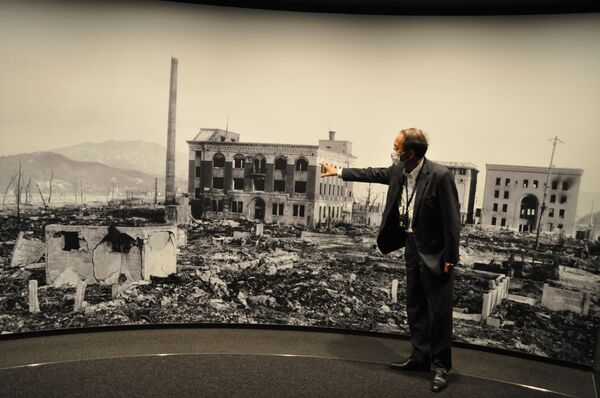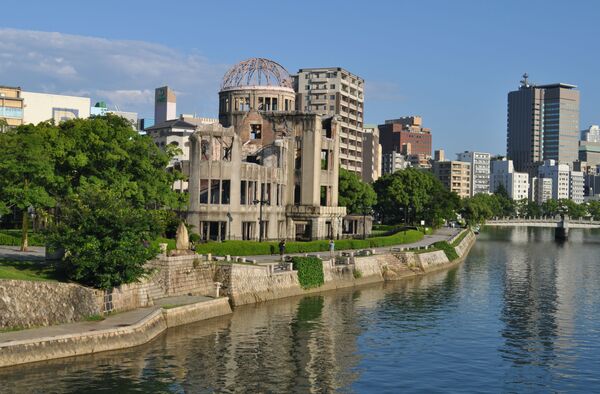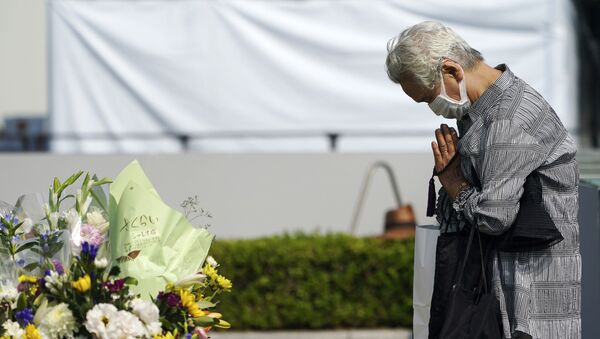Being in Hiroshima is very exciting not only because the city reminds one of a terrible tragedy. Today, the average age of the Hibakusha (people affected by the 1945 atomic bombings of Hiroshima and Nagasaki) is 84. It's believed that there are about 130,000 Hibakusha left throughout Japan.
According to the Japanese news outlet Kyodo, about 25 percent of respondents noted that they are less likely to take part in seminars and discussions on the atomic bombing due to their health. Some 13 percent of respondents said they would no longer engage in educational activities, while 40 percent of respondents admitted that they had never shared their memories of the horrors of those years, because they were too young to remember anything. Only 19 percent of respondents said are in a condition to continue sharing their experience.

The current pandemic is worsening the situation. Most survivors believe that the coronavirus is preventing them from promoting the idea of eliminating nuclear weapons. With each passing year, fewer Hibakusha believe that progress will ever be made on this issue.
What can be done so that these people are not forgotten, so that no one else has to experience the nightmare of nuclear weapons? This is what Sputnik's correspondent was wondering about throughout the trip. She got the answer from various people she spoke to.
'We will preserve the truth about those events even after 100 years'
The first stop was the Hiroshima Peace Memorial Museum. There, Takuo Takigawa (61), the museum's new director appointed in April 2019, gave foreign journalists an hour-long tour, describing in detail how the museum's exhibition has changed after a huge renovation, the third of its kind in the museum's history.
"Our main mission is to tell the world the truth about the atomic bombing. Last year's renovation is the result of a decade of work carried out by university professors, the Hibakusha themselves, and the museum's experts. This way we've managed to collect a very wide range of opinions", Takigawa explained.
The museum's transformation attracted widespread attention. In 2019, the number of visitors reached 1.76 million, breaking the 2016 record (1.74 million) when Barack Obama became the first US president to pay an official visit.
After the renovation, a large number of photographs and belongings of those who died during the 1945 atomic bombing of Hiroshima appeared in the museum. A separate section appeared dedicated to foreigners who also suffered during the attack. Takigawa explained the decision to decisively reject artificially created exhibits.
"The main concept of the renovation is to preserve the truth about the events of those years even after 100 years, when the Hibakusha will no longer be with us. For this we were guided by naturalism. That is why we have removed the mannequins depicting atomic bomb victims, and decided to no longer exhibit anything artificial".
In addition to such well-known exhibits as the "Human Shadow Etched in Stone" and "Shinichi’s tricycle", the museum has managed to collect more than 5,000 drawings by witnesses of those terrible events.

Moreover, during the demonstration of the wall with real traces of the so-called "black rain", Takigawa said that on 29 July, a Hiroshima court had ruled that 84 people exposed to radiation due to toxic fallout outside the special zones established by the government were finally recognised as Hibakusha.
Regional authorities have repeatedly asked to recognise "black rain" victims outside the special zones as Hibakusha, to include them in the free medical care programme. But due to a lack of scientific evidence on the rain's effects on the health of people in Hiroshima's suburbs, the central government rejected such requests. Although nine of the victims are no longer alive, this decision was the first real achievement in this matter over the past 75 years.

Since last year, Takigawa has set a goal of recording as many eyewitness accounts of the atomic bombing as possible. The plan was that 37 Hibakusha would take part in the filming and that the project would take 2 years. The coronavirus, however, may alter these plans a little, Takigawa said.
"I think the coronavirus will certainly have a slight impact on the whole process. But we want to complete it by all means. There is also a kind of opposite effect here. Due to the virus, the museum was closed for three months; and then we decided to start posting the already filmed 60-minute Hibakusha video evidence on the internet. We realised how important it is to continue our online activities".
'The year I would like to forget'
After the museum tour, Sputnik’s correspondent met with Teramoto Takashi (85), who miraculously survived the 1945 atomic bombing. At the time of the explosion Teramoto was in his house just a kilometre from the epicentre of the explosion. The probability of surviving at this distance is estimated at 50%. Many of those who were very close to Teramoto during the bombing died.
"Towards the end of World War II, the Americans actively attacked Japan's main cities. Since April 1945, primary schoolchildren had been evacuated to save them from air strikes. I was a fifth grader then, and my classmates and I were sent to the temple on the mountain. Every now and then we tried to run away, because we felt very homesick and there was nothing to eat. But they brought us back. My mom visited me on 4 August to take me to the doctor. We had originally planned to come back home on 6 August, but I was so anxious to get home as soon as possible that, despite my mother's tiredness, I convinced her to go back the same day. If we had returned on 6 August, we would have avoided the atomic bombing. I still regret it. My mother would have survived", Teramoto said.
"On the morning of 6 August, I was at home, writing a letter to my friend who was in a shelter. Suddenly I saw a flash of light. Everything went completely dark. I had no idea what happened. On the street, I met our neighbour who didn't recognise me, because it turned out that I was wounded in the head and my face was covered in blood. I tried to find my mother, but the woman convinced me that they would save her, and that we needed to run. She carried me on her back".
"When we were running, I saw a woman buried up under the rubble. I still cannot forget her crazed eyes, moving from side to side. The fire was spreading so quickly. I'm afraid she died", he said.

"On the way we stopped at Yokogawa, there were many seriously injured people there. But there was no medicine or medical equipment. They just covered my head with white clothes. I saw one of my friends who I used to play with. He had severe burns and walked with his arms outstretched. It looked like tufts of clothing were hanging from his arms. Only up close did I realise that those were pieces of skin. Later I was told that he had died a couple of days later. The neighbour who had saved me died 2-3 months later. The same happened to many others who had gathered in Yokogawa".
"Later I moved to a village to live with my aunt. They took very good care of me. My father told me that my mother had been saved, so I was eager to see her again when she recovered. But that never happened. As it turned out, my mother was getting weaker every day and she died on 15 August", Teramoto said.
"At the end of August, I found myself losing my hair. My whole body ached. I couldn't do anything, just lie in bed for days. Between bouts of sleep I heard people say: 'People who are faced with an atomic bomb suddenly start losing their hair, their gums start bleeding, and purple spots appear on their body, and then die one. I hope this child will survive'. I thought they were probably discussing me".
"But I survived. A year later, in April 1946, I returned to school, went back to the fifth grade. But I couldn't forget 1945. It still hurts me to this day that I made my mother worry and that she died such a cruel death. Various thoughts and feelings have burdened me throughout my life", Teramoto said.
Having experienced such a tragedy, how can one find the strength to forgive and live on? This is probably the most common question any Hibakusha is asked.
"I am often asked if I hate the US. My mother was killed, as well as the friends I used to play with. Since they died from the atomic bomb, I cannot say that 'there is no hatred in me'. I did hate the US. However, years later, I had children, and grandchildren, and I no longer feel either hatred or anger. All I want to say is that this should never happen again, such cruelty can no longer be tolerated. This is my genuine desire. When I share my experience with you like this, I don’t feel hatred, I just want to tell the truth about those events that must not be forgotten so that this never happens again. The most important thing is that people live in peace with each other, feel the connection that brings them together, and help each other", he concluded
'Grab peace and keep it safe'
Okamoto Toshiko, an a-bomb legacy successor, came to the meeting together with Teramoto. Okamoto was neither born nor raised in Hiroshima, but she came from Tokyo to contribute to preserving the memory of the atomic bombing victims, and has lived here for almost 30 years.
"When I first came to Hiroshima, I wondered what it would be like to survive the atomic bombing. How did the Hibakusha live after that? What thoughts did they have? I thought I would like to know about all this, so I joined the a-bomb legacy successor programme", she said.
"Is the war really over? Are we going to face it again? Will nuclear weapons never be used? These are the questions that worried me during my studies. And I must say, I don't know. But what I do know is that we can learn a lot by studying the past. And this is the most important thing. Thanks to this programme, I realised what I can do. Namely, talk to people. Answer their questions. Make every effort to make people understand how important the topic of peace is today".
According to Okamoto, about 40 Hibakusha now take part in the museum's seminars to share their stories. As for the successors, there are about 150 of them at the moment.
"The programme involves three years of studies. In the first year, you study everything related to the atomic bomb, as well as the history of Hiroshima. In the second year, you interact with Hibakusha who want to share their experiences. And then there's the most difficult part: you have to write a paper based on everything you have learned; you then have to make a 45-minute presentation of your paper. Hibakusha assess you; if everything is alright, you become a successor".
Currently the a-bomb legacy successor programme has been suspended due to the coronavirus. But Okamoto expects the museum to soon launch zoom meetings, which will help to continue its activities.
"You can learn something from every Hibakusha. One of them once told me: 'Do you live in peace now? Peace is such a thing that immediately runs away. Please grab it and then protect it gently it in your hands.' I think only a Hibakusha who lived before, during, and after the war can say such things".
"Japan is the only country to have survived an atomic bombing. However, nuclear tests were also carried out in Australia and the United States; and people there also suffered from this. That is why it is so important to tell the world about Japan's experience. I think this is the path to peace", she concluded.
'You can take peace from here'
At the end of the trip, the Sputnik correspondent also talked to two young volunteers at the Hiroshima Peace Museum. As the day of the trip coincided with the end of the rainy season, they managed to talk while walking in the sun-drenched Peace Memorial Park, as well as near the Peace Memorial.
They started volunteering not long ago, in June of last year, yet by February of this year, the young volunteers had already managed to give tours to 232 foreign tourists from more than 40 countries and regions.
One of the most frequently asked questions is why young people in Hiroshima are doing this kind of work. Ikeda Fuuda (2nd year student at Hiroshima University) always wanted to try his hand at being English-speaking guide, telling as many people as possible about the history and modern era of his hometown. And although questions from foreign tourists are sometimes very difficult to answer, he likes such communication.
"There are usually a lot of questions about international relations. For example, they ask me about the American 'nuclear umbrella', or want to know my opinion regarding the fact that Japan didn't sign the TPNW. I believe that Japan, as the only country that survived an atomic bombing, should play a key, leading role in moving towards a nuclear-free world".
Nomura Mikaeru Kai (3rd year student at Hiroshima University) grew up in the Philippines and lived there for about 18 years. His mother is Japanese, so he decided to go to a Japanese university.
"We conduct tours not for Japanese people, but for foreigners. Therefore, I thought that since I know how foreigners usually look at history, it would be easier for me to find common ground with foreign tourists".
As a result of the 1945 bombing, Hiroshima, whose population at that time was about 350,000, lost about 140,000 people. The city is now home to 1,990,000 residents.
by Eleonora Shumilova





